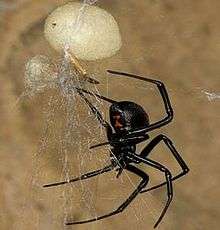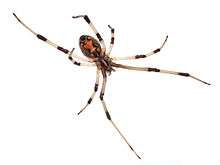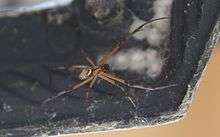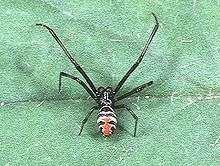Latrodectus
| Latrodectus | |
|---|---|
| | |
| Scientific classification | |
| Kingdom: | Animalia |
| Phylum: | Arthropoda |
| Subphylum: | Chelicerata |
| Class: | Arachnida |
| Order: | Araneae |
| Infraorder: | Araneomorphae |
| Family: | Theridiidae |
| Genus: | Latrodectus Walckenaer, 1805[1] |
| Species | |
|
31 described species,[2] estimated 65 species living | |
Latrodectus is a genus of spiders in the family Theridiidae, most of which are commonly known as widow spiders. The genus contains 31 recognized species[2] distributed worldwide, including the North American black widows (L. mactans, L. hesperus, and L. variolus), the button spiders of Africa, and the Australian redback spider. Species vary widely in size. In most cases, the females are dark-colored and readily identifiable by reddish hourglass-shaped markings on the abdomen.
The venomous bite of these spiders is considered particularly dangerous because of the neurotoxin latrotoxin, which causes the condition latrodectism, both named for the genus. The female black widow has unusually large venom glands and its bite can be particularly harmful to humans. However, despite the genus' notoriety, Latrodectus bites are rarely fatal. Only female bites are dangerous to humans.
Description
Female widow spiders are typically dark brown or a shiny black in color when they are full grown, usually exhibiting a red or orange hourglass on the ventral surface (underside) of the abdomen; some may have a pair of red spots or have no marking at all. The male widow spiders often exhibit various red or red and white markings on the dorsal surface (upper side) of the abdomen, ranging from a single stripe to bars or spots. Females of a few species are paler brown and some have no bright markings. The bodies of black widow spiders range from 3 to 10mm in size, some females can measure 13mm in their body length.[3]
Behavior
The prevalence of sexual cannibalism, a behavior in which the female eats the male after mating, has inspired the common name "widow spiders".[4] This behavior may promote the survival odds of the offspring;[5] however, females of some species only rarely show this behavior, and much of the documented evidence for sexual cannibalism has been observed in laboratory cages where the males could not escape. The male black widow spiders tend to select their mates by determining if the female has eaten already to avoid getting eaten themselves. They are able to tell if the female has fed by sensing chemicals in the web. [6]
Like other members of the family Theridiidae, widow spiders construct a web of irregular, tangled, sticky silken fibers. Black widow spiders prefer to nest near the ground in dark and undisturbed areas. Usually in small holes produced by animals, or around construction openings or wood piles. Indoor nests are in dark, undisturbed places as well such as; under desks or furniture, in the basement.[7] The spider very frequently hangs upside down near the center of its web and waits for insects to blunder in and get stuck. Then, before the insect can extricate itself, the spider rushes over to bite it and wrap it in silk. To feed, it uses its fangs to inject digestive enzymes, liquefying the prey's internal organs.[8] Their prey consists of small insects such as; flies mosquitoes, grasshoppers, beetles, and caterpillars. [9]If the spider perceives a threat, it quickly lets itself down to the ground on a safety line of silk. As with other web-weavers, these spiders have very poor eyesight and depend on vibrations reaching them through their webs to find trapped prey or warn them of larger threats. When a widow spider is trapped, it is unlikely to bite, preferring to play dead or flick silk at the potential threat; bites are the result of continual harassment.[10] While some species are more aggressive, most are not; many injuries to humans are due to defensive bites delivered when a spider gets unintentionally squeezed or pinched.
The ultimate tensile strength and other physical properties of Latrodectus hesperus (western black widow) silk were found to be similar to the properties of silk from orb-weaving spiders that had been tested in other studies. The tensile strength for the three kinds of silk measured in the Blackledge study was about 1000 MPa. The ultimate strength reported in a previous study for Nephila edulis was 1290 ± 160 MPa.[11] The tensile strength of spider silk is comparable to that of steel wire of the same thickness.[12] However, as the density of steel is about six times that of silk,[13] silk is correspondingly stronger than steel wire of the same weight.
Spiders of the genus Steatoda (also of the Theridiidae family) are often mistaken for widow spiders, and are known as "false widow spiders"; they are significantly less harmful to humans.
Species


Arachnologist Herbert Walter Levi revised the genus Lactrodectus in 1959, studying the female sexual organs and noting their similarity across described species. He concluded the color variations were variable across the world and were not sufficient to warrant species status, and reclassified the redback and several other species as subspecies of the black widow spider.[14]
Levi also noted that study of the genus had been contentious; in 1902, both F.P Cambridge and Friedrich Dahl had revised the genus, with each criticising the other. Cambridge questioned Dahl's separating species on what he considered minor anatomical details, and the latter dismissed the former as an "ignoramus".[14]
The southern black widow, as well as the closely related western and northern species which were previously considered the same species, has a prominent red hourglass figure on the underside of its abdomen. Many of the other widow spiders have red patterns on a glossy black or dark background, which serve as a warning. Spiders found in multiple regions are listed in their predominant native habitat.
Widow spiders can be found on every continent of the world except Antarctica. In North America, the black widows commonly known as southern (Latrodectus mactans), western (Latrodectus hesperus), and northern (Latrodectus variolus) can be found in the United States, as well as parts of southern Canada - particularly in the Okanagan Valley of British Columbia, as can the "gray" or "brown widow spiders" (Latrodectus geometricus) and the "red widow spiders" (Latrodectus bishopi).[15] The most prevalent species occurring in Australia is commonly called the redback (Latrodectus hasselti). African species of this genus are sometimes known as button spiders.
Americas



The following widow spiders are indigenous to North America:
- Latrodectus bishopi, the red widow, Florida
- Latrodectus hesperus, the western black widow, widespread range across the Western United States and extreme southern Canada, ranging east to Oklahoma, and south to Mexico
- Latrodectus mactans, the black widow spider (sometimes called the southern black widow), warm regions of the USA
- Latrodectus variolus, the northern black widow, from the extreme southeastern part of Canada and south to northern Florida, with frequency higher in the northern part of this range
The following are indigenous to Central and South America:
- Latrodectus antheratus, Paraguay, Argentina
- Latrodectus apicalis, Galapagos Islands
- Latrodectus corallinus, Argentina
- Latrodectus curacaviensis, Lesser Antilles, South America
- Latrodectus diaguita, Argentina
- Latrodectus mirabilis, Argentina
- Latrodectus quartus, Argentina
- Latrodectus thoracicus, Chile
- Latrodectus variegatus, Chile and Argentina
Europe, North Africa, the Middle East, and western Asia

The following widows are indigenous to the Mediterranean region, as well as in western Asia:
- Latrodectus dahli, Middle East to central Asia
- Latrodectus hystrix, Yemen, Socotra
- Latrodectus lilianae, Iberian Peninsula
- Latrodectus pallidus, the white widow or white steppe spider, North Africa, the Middle East, Russia, Iran, Cape Verde
- Latrodectus revivensis, Israel, Palestine
- Latrodectus renivulvatus, a black button spider found in Africa, Saudi Arabia, and Yemen
- Latrodectus tredecimguttatus, the Mediterranean black widow or European black widow, Mediterranean area, central Asia, Kazakhstan, also reported in China, some specimens are reported as L. lugubris
Sub-Saharan Africa and Madagascar
- Latrodectus cinctus, a black button spider found in southern Africa, Cape Verde, and Kuwait
- Latrodectus indistinctus, a black button spider found in South Africa and Namibia
- Latrodectus karrooensis, a black button spider found in South Africa
- Latrodectus menavodi, found in Madagascar
- Latrodectus obscurior, found in Cape Verde and Madagascar
- Latrodectus rhodesiensis, a brown button spider found in Zimbabwe
- Latrodectus geometricus, a brown button spider found in Southern African savannah

South and Eastern Asia
- Latrodectus elegans, China, Myanmar, Japan
- Latrodectus erythromelas, India, Sri Lanka
- Latrodectus ex laos, Laos
Australia and Oceania
- Latrodectus hasseltii, the redback, native to Australia, also found imported into Southeast Asia and New Zealand
- Latrodectus katipo, the red katipo, found in New Zealand
Worldwide
- Latrodectus geometricus, the brown widow, grey widow, or brown button spider is found in Africa, the USA, South America, and Australia. It is unclear where this spider originated; however, it has been discovered in many warm, cosmopolitan locales.
Bite
Due to the presence of latrotoxin in their venom, black widow bites are potentially dangerous and may result in systemic effects (latrodectism) including severe muscle pain, abdominal cramps, hyperhidrosis, tachycardia, and muscle spasms.[18] Symptoms usually last for 3–7 days, but may persist for several weeks.[19]
Each year, about 2,200 people report being bitten by a black widow, but most recover within 24 hours with medical treatment (male spiders produce the toxins to help with their own hunting, but they make such a diluted version that they’re not harmful to most people). Also, many people who are bitten develop few symptoms since the spider may not inject its venom. Black widows are not especially aggressive spiders, and they rarely bite humans unless startled or otherwise threatened.[20]
Contrary to popular belief, most people who are bitten suffer no serious damage, let alone death. Fatal bites were reported in the early 20th century mostly with Latrodectus tredecimguttatus, the Mediterranean black widow.[21]
Since the venom is not likely to be life-threatening, antivenom has been used as pain relief and not to save lives.[22] However, a study demonstrated that antivenom and placebo added to standardized pain medication had similar improvement in pain and resolution of symptoms.[22]
See also
References
- ↑ "Gen. Latrodectus Walckenaer, 1805", World Spider Catalog, Natural History Museum Bern, retrieved 2016-01-28
- 1 2 "Species list for Latrodectus". World Spider Catalog. Natural History Museum Bern. Retrieved 2016-01-28.
- ↑ "Black Widow Spiders". Orkin. Retrieved 4 November 2016.
- ↑ Breene, R. G.; Sweet, M. H. (1985). "Evidence of insemination of multiple females by the male Black Widow Spider, Latrodectus mactans (Araneae, Theridiidae)" (PDF). The Journal of Arachnology. 13 (3): 331–335.
- ↑ "Male spiders let females eat them for kids' sake: Study". livescience. 23 December 2011. Retrieved 23 December 2011.
- ↑ "Male black widows prefer to mate with females who have just eaten (so they don't become her next meal)". Mail Online. Retrieved 4 November 2016.
- ↑ "Black Widow Spider - Facts, Bite & Habitat Information". Animal Corner. Retrieved 4 November 2016.
- ↑ "Animals: Black Widow Spider". National Geographic. Retrieved 14 May 2014.
- ↑ "Black Widow Spiders | National Geographic". 10 September 2010. Retrieved 17 November 2016.
- ↑ Nelsen, David; Kelln, Wayne; Hayes, William. "Poke but don't pinch: risk assessment and venom metering in the western black widow spider, Latrodectus hesperus". Animal Behaviour. 89: 107–114. doi:10.1016/j.anbehav.2013.12.019. Retrieved 12 October 2015.
- ↑ Blackledge, Todd; et al. "Quasistatic and continuous dynamic characterization of the mechanical properties of silk from the cobweb of the black widow spider Latrodectus hesperus, table 1". The Company of Biologists. Retrieved 2009-01-23.
- ↑ "Astm a36". OnlineMetals.com. Retrieved 2009-01-25.
- ↑ Elices, Manuel; Guinea, Gustavo V.; Pérez-Rigueiro, José; Plaza, Gustavo R.; et al. (2005). "Finding Inspiration in Argiope Trifasciata Spider Silk Fibers". JOM. 57 (2): 60–66. Bibcode:2005JOM....57b..60E. doi:10.1007/s11837-005-0218-7. Retrieved 2009-01-23.
- 1 2 Levi, Herbert W. (1959). "The Spider Genus Latrodectus (Araneae, Theridiidae)". Transactions of the American Microscopical Society. 78 (1): 7–43. doi:10.2307/3223799. JSTOR 3223799.
- ↑ (Preston-Malfham, 1998).
- ↑ Sutton, Marion. "Field identification of katipo" (PDF). DOC RESEARCH & DEVELOPMENT SERIES 237. Science & Technical Publishing Department of Conservation. Retrieved 9 September 2013.
- ↑ Vink, Cor J.; Sirvid, Phil J.; Malumbres-Olarte, Jagoba; Griffiths, James W.; Paquin, Pierre; Paterson, Adrian M. (2008). "Species status and conservation issues of New Zealand's endemic Latrodectus spider species (Araneae: Theridiidae)". Invertebrate Systematics. Collingwood, Vic., Australia: CSIRO Publishing. 22 (6): 589–604. doi:10.1071/IS08027. ISSN 1445-5226. OCLC 50150601.
- ↑ Ushkaryov, YA; english, A; Sugita, S (2008). "alpha-Latrotoxin and its receptors". Handbook of experimental pharmacology. Handbook of Experimental Pharmacology. 184 (184): 171–206. doi:10.1007/978-3-540-74805-2_7. ISBN 978-3-540-74804-5. PMC 2519134
 . PMID 18064415.
. PMID 18064415. - ↑ Peterson, ME (November 2006). "Black widow spider envenomation". Clinical techniques in small animal practice. 21 (4): 187–90. doi:10.1053/j.ctsap.2006.10.003. PMID 17265903.
- ↑ Why Black Widow Spider Venom Is So Potent. By Jennifer Viegas, Discovery News January 6, 2015
- ↑ Bettini, S (1964). "Epidemiology of latrodectism". Toxicon. 2 (2): 93–102. doi:10.1016/0041-0101(64)90009-1. PMID 14301291.
- 1 2 Isbister, Geoffrey K.; Page, Colin B.; Buckley, Nicholas A.; Fatovich, Daniel M.; Pascu, Ovidiu; MacDonald, Stephen P.J.; Calver, Leonie A.; Brown, Simon G.A. (2014). "Randomized Controlled Trial of Intravenous Antivenom Versus Placebo for Latrodectism: The Second Redback Antivenom Evaluation (RAVE-II) Study". Annals of Emergency Medicine. 64: 620–8.e2. doi:10.1016/j.annemergmed.2014.06.006. PMID 24999282. (subscription required (help)).
Further reading
- Insects and Spiders. New York: St. Remy Media Inc. / Discovery Books. 2000. p. 35.
- Freeman, Scott (2003). Biological Science. Prentice-Hall.
- Hillyard, Paul (1994). The Book of Spiders. New York: Random House, Inc. pp. 47–50.
- Hillyard, Paul (1994). The Book of the Spiders. New York: Avon Books. pp. 22–35.
- Martin, Louise (1988). Black Widow Spiders. Rourke Enterprises, Inc. pp. 18–20.
- Preston-Malfham, Ken (1998). Spiders. Edison, New Jersey: Chartwell Books. p. 40.
- "Arthropod". Microsoft Encarta Online Encyclopedia. 2004.
- Abalos, J. W. (1962). "The egg-sac in the Identification of Species of Latrodectus (Black-Widow Spiders)" (PDF). Retrieved September 26, 2013.
- Levi, H. W.; McCrone, J. D. (1964). "North American Widow Spiders of the Latrodectus curacaviensis Group".
External links
![]() Media related to Latrodectus at Wikimedia Commons
Media related to Latrodectus at Wikimedia Commons
![]() Data related to Latrodectus at Wikispecies
Data related to Latrodectus at Wikispecies
- Tree of Life: Latrodectus
- Black Widow Spider: Large format photographs and information
- Description of crossing experiments between various Latrodectus species
- widow spider parasitoids on the UF / IFAS Featured Creatures Web site
- ↑ "Black Widow Spiders". orkin. Retrieved 4 November 2016.
